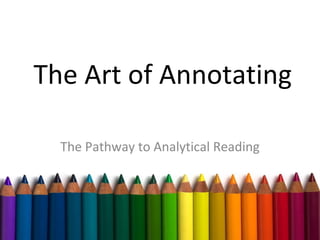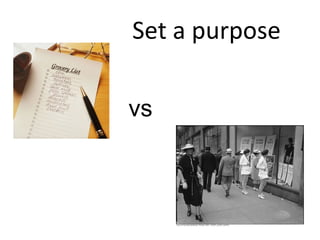How to annotate
- 1. The Art of Annotating The Pathway to Analytical Reading
- 2. The Profile of the Good Reader
- 3. Set a purpose vs
- 4. Connect what you are reading to… How does this relate to something else I’ve read? How does this relate to me? How does this relate to something else in my life—family, community, etc?
- 5. Ask QUESTIONS About the characters About the plot and how the author will unfold the narrative to you About information you don’t understand
- 6. Writers often give you hints or clues that help you "read between the lines." These clues give you a deeper understanding. When you infer , you go beyond the surface details to see other meanings that the details suggest or imply (not stated). When the meanings of words are not stated clearly in the context of the text, they may be implied - that is, suggested or hinted at. When meanings are implied, you may infer them.
- 7. From this To this
- 8. Evaluate and Judge What is the author ‘s thematic purpose? What ideas does the writer present that you agree with? Disagree with? How relevant are these ideas to you? What previous ideas of yours has this work changed or amplified?
- 11. The Levels of a Literary Text: Moving from the PLOT to the THEMATIC PLOT LEVEL Things that can be answered with the question “What?” Things that concern events and setting and character descriptions. Things character does Plot-level outcome of character’s actions Other characters’ reactions to events/other characters Setting details
- 12. Figurative Level Things that can be answered with the question “Why?” or “How?” Things that consider characters in the narrative as both dynamic people and also the result of artistic choices: People with goals, passions, ambitions, fears and desires. When we INFER things about the “hidden” life of a character and what motivates him/her When we consider literary devices and techniques that an author uses to connect certain emotions or ideas with a character, place, or event.
- 13. And the last and most sophisticated Level: THEMATIC Level when we can make thematic evaluations and statements. when we say that such and such a character/ represents a CONCEPT or an IDEA by his very construction; these take on a greater significance, and become a commentary on a deeper message, or overall point the author is conveying. When we consider overarching ideas or universal themes that the author has asked us to consider
- 14. What does “annotate” mean? Annotation is a method of writing down your ideas of a text: To trace your reading (setting purpose, asking questions, connecting, summarizing, inferring) To develop your understanding of literary analysis (plot, figurative, thematic)
- 15. Good annotations will have a balance of written ideas of Your own thoughts, connections and ideas With Your understanding of the author’s ideas and intentions
- 16. Only Gatsby, the man who gives his name to this book, was exempt from my reaction—Gatsby—who represented everything for which I have an unaffected scorn. If personality is a series of successful gestures , then there was something gorge ous about him, so me heightened sen sitivity to the pro mises of life, as if he were related to one of those intricate machines that register earthquakes ten thousand miles away. Text to SELF: I’ve met people who seem to be part of a group of people you hate but then turn out to be likable for some reason Text to World : celebrities often become representative of the rich, spoiled, American Dream even if they do not characterize the rest of the “celebrity world” The “was” indicates that he is either dead or this was written long after he was gorgeous Reader Connections
- 17. Gatsby—who represented everything for which I have an unaffected scorn. If personality is a series of successful gestures, then there was something gorgeous about him, some heightened sensitivity to the promises of life, as if he were related to one of those intricate machines that register earthquakes ten thousand miles away (Fitzgerald 3). This metaphor, comparing your personality to a series of choreographed, physical movements makes it seem like he is graceful Why does he evoke both “scorn” and “gorgeous” qualities? How is he more sensitive to the “promises of life”? Does this mean he is more hopeful or more depressed? Comparing him to a seismograph makes it seem as if he is “in tune” with FATE or “Lady Luck” and that things must always go his way, or that is what he must believe
- 18. Gatsby—who represented everything for which I have an unaffected scorn. If personality is a series of successful gestures, then there was something gorgeous about him, some heightened sensitivity to the promises of life, as if he were related to one of those intricate machines that register earthquakes ten thousand miles away (Fitzgerald 3). So Gatsby represents what he doesn’t like He’s good looking I don’t get what this means Unproductive Annotations
- 19. Comment on a specific image Make a general comment about an entire line or whole quotation Mention literary devices/elements Just discuss “words” or “images” Mention authorial intent/ or at least try to speculate authorial intention Just mention your own opinion about the text
Editor's Notes
- #4: Reading is like shopping. In English class, you aren’t cruising the mall, window shopping with no specific purpose. This isn’t a bad thing; it can be fun just to peruse the mall and wander around a store to see what catches your eye. This is what you do when you read on your own. It doesn’t matter if you notice that sweater or not. Who cares? You don’t have any specific item you need to buy so you’re just wandering in and out and if you miss a store, it doesn’t matter. On the other hand, sometimes you are shopping for a specific thing , where you think ahead of time what item you need and thinking about the stores that will possibly have this item. While you might get occasionally sidetracked (and buy something that wasn’t on the list), you ultimately have to purchase something. This is the way it is in English class; you should have a mental “list” of what you are seeking to know. This list can change from chapter to chapter. Some things we want to know in English class are: Is this the bad guy? What are his intentions? Will he be rescued? Is this girl important to the storyline? What will he do next? How will he come to terms with this experience? Your purposes for reading should evolve as the narrative progresses.



















